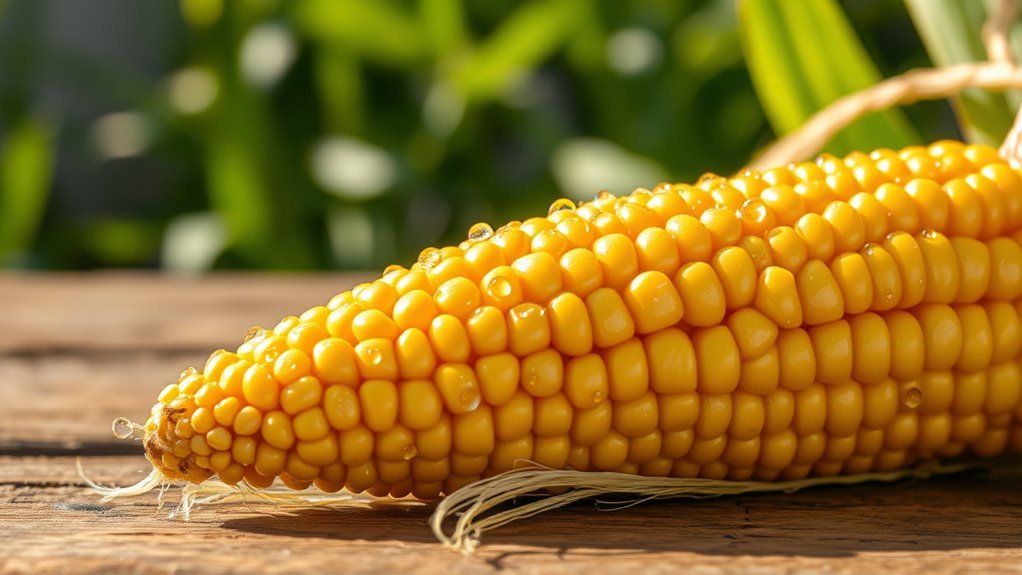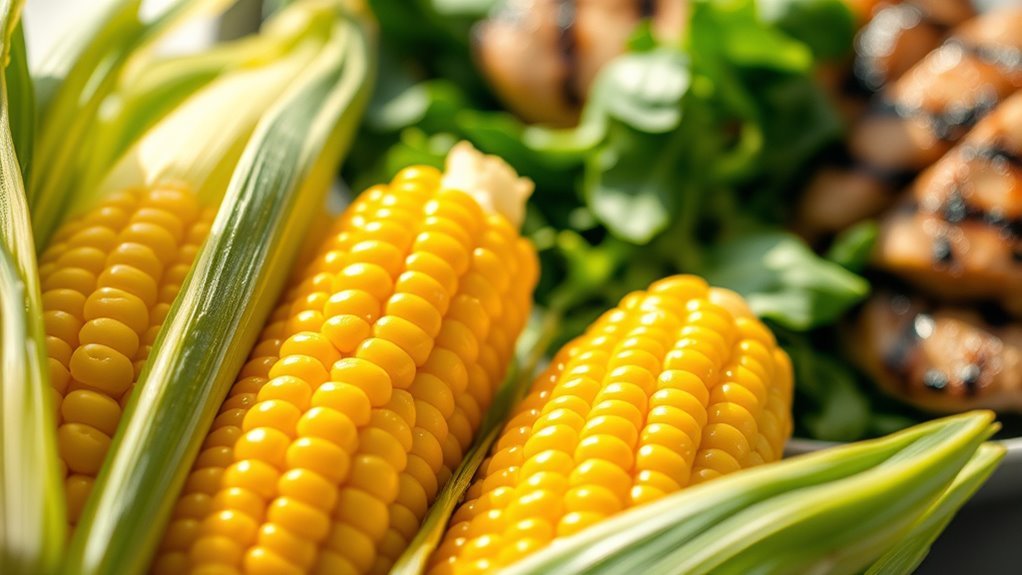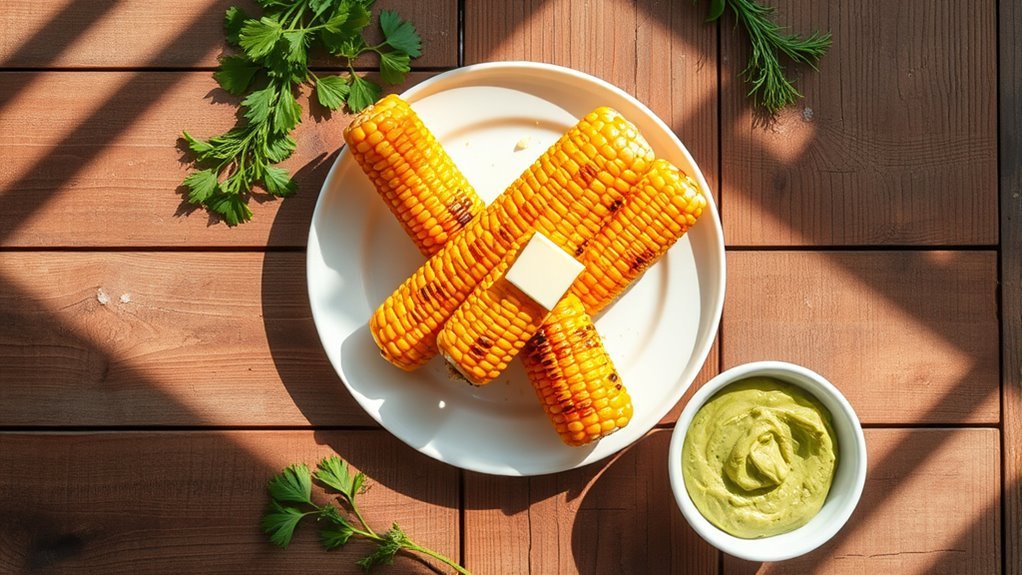You can’t have corn on a ketogenic diet in large amounts due to its high carb content. Sweet corn, for instance, has about 25 grams of carbs per cup, making it challenging to stay within the recommended limit of 20-50 grams daily. However, you can enjoy corn in small portions as a garnish or mix it with low-carb vegetables. Thoughtful choices and alternatives can help you manage your carb intake effectively. There’s more to explore about managing corn in your keto journey.
Understanding Ketosis and Carbohydrate Limits

Understanding ketosis and carbohydrate limits is essential for anyone considering a ketogenic diet. When you enter ketosis, your body shifts from burning carbohydrates for energy to using fats, which can lead to several ketosis benefits, including weight loss and improved mental clarity. To achieve and maintain this metabolic state, you need to be aware of your carb intake. Most ketogenic diets recommend limiting carbs to around 20-50 grams per day. This carb awareness helps you make informed food choices, ensuring you stay within your limits. It’s important to recognize that not all carbs are created equal; focusing on quality sources can optimize your results. By understanding these principles, you can enjoy the freedom of a ketogenic lifestyle while reaping its numerous benefits.
Nutritional Profile of Corn

Corn, often seen as a staple in many diets, has a nutritional profile that raises questions for those following a ketogenic lifestyle. It provides essential vitamins and minerals, including B vitamins, magnesium, and fiber, which can support overall health. However, corn’s drawbacks lie in its higher carbohydrate content, making it a potential challenge for those aiming to maintain ketosis. While corn can offer some health benefits, like antioxidants and energy, its glycemic index may spike blood sugar levels, conflicting with keto goals. Understanding these factors is vital; you’ll want to weigh corn’s benefits against its drawbacks to make an informed choice. Ultimately, moderation and careful consideration of your individual carb limits are key to maneuvering corn’s role in your diet.
Types of Corn and Their Carbohydrate Content

When considering corn on a keto diet, it’s important to understand the different types and their carbohydrate content. Each variety, from sweet corn to popcorn, has its own nutritional profile, which can greatly affect your carb intake. By knowing the carb counts, you can make more informed choices that align with your dietary goals.
Corn Types Overview
Steering through the world of corn can be tricky, especially when you’re trying to stick to a ketogenic diet. There’s a wide array of corn varieties, each with unique characteristics and culinary applications. For instance, sweet corn is often enjoyed fresh or in salads but carries more carbohydrates compared to other types. On the other hand, popcorn, while a popular snack, can also be quite high in carbs, making it less suitable for keto. Then there’s cornmeal, typically used in baking, which is another high-carb option. Understanding these differences can empower you to make informed choices that align with your dietary goals, allowing you to enjoy delicious meals without compromising your keto lifestyle.
Carb Counts Explained
While you might enjoy the taste of corn, it’s important to understand its carbohydrate content, especially on a ketogenic diet. Carb counting is vital for staying within your daily limit on keto. Here’s a quick look at different types of corn and their carb counts:
| Type of Corn | Serving Size | Net Carbs (g) |
|---|---|---|
| Sweet Corn | 1 cup | 27 |
| Cornmeal | 1/4 cup | 24 |
| Corn on the Cob | 1 ear | 24 |
| Popcorn (air-popped) | 3 cups | 18 |
| Corn Tortilla | 1 tortilla | 20 |
Understanding these carb counts helps you make informed choices and maintain your freedom on the keto diet while enjoying the flavors you love.
Sweet Corn vs. Field Corn: What’s the Difference?
When you think about corn, it’s important to know that sweet corn and field corn serve different purposes and have distinct nutritional profiles. Sweet corn is often enjoyed fresh and has a higher sugar content, while field corn is primarily used for animal feed and industrial products. Understanding their culinary uses and how they’re grown can help you make informed choices about incorporating corn into your diet.
Nutritional Profiles Comparison
Understanding the nutritional differences between sweet corn and field corn is essential, especially if you’re considering how they fit into a keto diet. Sweet corn, typically higher in sugar and carbs, contains around 25 grams of carbs per cup, making it less keto-compatible. In contrast, field corn, often used for animal feed and processed products, has a higher starch content and is generally not consumed directly, rendering it unsuitable for your diet.
When evaluating corn varieties, sweet corn’s sweeter flavor and tender texture might appeal to some, but its carb count can hinder your keto goals. Ultimately, if you’re committed to a ketogenic lifestyle, it’s vital to monitor your intake and consider alternatives that align better with your dietary preferences.
Culinary Uses Explained
Corn serves different culinary purposes depending on its variety, as sweet corn and field corn have distinct uses in the kitchen. Understanding these differences helps you make informed choices for your meals. Here are four key distinctions:
- Sweet Corn: Ideal for fresh eating, grilling, or adding to salads, it offers a tender texture and a burst of sweetness.
- Field Corn: Primarily used for animal feed or processed into products like cornmeal and corn syrup, it has a more starchy flavor profile.
- Cooking Techniques: Sweet corn shines in quick cooking methods, while field corn benefits from longer cooking times.
- Corn Pairings: Sweet corn pairs well with herbs and spices, while field corn complements savory dishes and hearty flavors.
Embrace these culinary adaptations to elevate your corn dishes!
Growth and Harvesting Differences
Various factors influence how sweet corn and field corn are grown and harvested, impacting their overall quality and use. Sweet corn is typically harvested when the kernels are tender and sugary, making it ideal for fresh consumption. In contrast, field corn is left to mature fully, allowing for a higher starch content, which is suited for animal feed and processed products. The corn growth cycle for sweet corn is shorter, usually around 70-100 days, while field corn takes 90-120 days to reach maturity. During corn harvesting, sweet corn is picked by hand or machine when it’s at its peak, whereas field corn is harvested when the kernels are dry, ensuring a longer shelf life. Understanding these differences helps you appreciate their distinct roles in agriculture.
Is Corn Starch Keto-Friendly?
Is corn starch a suitable option for your keto diet? While it’s a common thickener, it’s high in carbohydrates, making it less than ideal for ketosis. If you’re looking for alternatives, consider these keto-friendly thickeners:
- Xanthan Gum: A little goes a long way, adding thickness without carbs.
- Guar Gum: Great for sauces and gravies, it’s low in digestible carbs.
- Psyllium Husk: This fiber-rich option can thicken while supporting digestion.
- Coconut Flour: Not only low in carbs, but it also adds a subtle coconut flavor.
Alternatives to Corn on a Keto Diet
When you’re following a keto diet, it’s crucial to find low-carb vegetable options that can replace corn in your meals. Alternatives like cauliflower, zucchini, and spinach not only fit your carb limits but also add variety to your plate. Additionally, exploring keto-friendly grain substitutes such as almond flour or coconut flour can help you create satisfying dishes without compromising your diet.
Low-Carb Vegetable Options
Although corn is a popular vegetable, it doesn’t fit well into a keto diet due to its high carbohydrate content. Fortunately, there are plenty of low-carb vegetable substitutes that can satisfy your cravings while keeping you in ketosis. Here are four great options:
- Zucchini – Versatile and can be spiralized or grilled for “noodles.”
- Cauliflower – Perfect for rice or mashed potato substitutes.
- Broccoli – A nutrient-dense choice, great for stir-fries or steamed as a side.
- Spinach – Low in carbs and packed with vitamins; ideal for salads or smoothies.
Incorporating these vegetables into your meals can help you create delicious low-carb snacks, ensuring you enjoy variety while sticking to your keto goals.
Keto-Friendly Grains Alternatives
If you’re looking to replace high-carb grains like corn on your keto diet, several alternatives can help you maintain your low-carb lifestyle without sacrificing taste or texture. One great option is cauliflower rice, which mimics the texture of traditional rice while being low in carbs. It’s versatile, easy to prepare, and can be used in various dishes.
Another alternative is quinoa, which, while slightly higher in carbs, offers numerous benefits. Quinoa is a complete protein, providing all nine essential amino acids, and is rich in fiber, making it a healthy choice if you can fit it into your carb allowance. By incorporating these options, you can enjoy satisfying meals while staying true to your keto goals.
How to Incorporate Corn Sparingly in Your Meals
While corn may not be the go-to vegetable on a keto diet due to its higher carbohydrate content, you can still enjoy it in moderation by incorporating it thoughtfully into your meals. Here are some tips for effective meal planning and portion control:
- Use Corn as a Garnish: Sprinkle corn on salads or soups to add flavor without overwhelming your carb count.
- Mix with Low-Carb Veggies: Combine small amounts of corn with cauliflower or zucchini to create a balanced dish.
- Limit Portion Sizes: Stick to a tablespoon or two to keep carbs in check.
- Opt for Fresh or Frozen: Choose fresh or frozen corn over processed options to avoid added sugars.
Potential Health Benefits of Corn
Even though corn isn’t a staple in a strict keto diet, it does offer several health benefits that can be valuable when consumed in moderation. Corn is rich in essential nutrients and provides dietary fiber, which aids digestion and helps maintain gut health. Additionally, it contains antioxidants like lutein and zeaxanthin, which support eye health.
Here’s a quick overview of the health benefits and nutrients in corn:
| Health Benefits | Corn Nutrients | Potential Effects |
|---|---|---|
| Rich in Fiber | Vitamin B6 | Supports digestion |
| Antioxidant Properties | Magnesium | Promotes heart health |
| Aids Eye Health | Folate | Reduces risk of birth defects |
| Energy Source | Carbohydrates | Provides quick energy |
Incorporating corn wisely can enhance your overall nutrition!
Recipes to Enjoy Corn While Staying Keto
Although corn is generally avoided on a strict keto diet due to its higher carbohydrate content, there are creative ways to enjoy it in moderation. You can incorporate corn into your meals while still adhering to your keto lifestyle. Here are some delicious corn dishes and keto snacks to try:
Corn can be enjoyed in moderation on a keto diet with creative dishes that keep carbs in check.
- Corn Salsa: Combine diced tomatoes, onions, cilantro, and a small amount of corn for a zesty dip.
- Corn Salad: Mix fresh corn with avocado, bell peppers, and lime juice for a revitalizing side.
- Zucchini Corn Fritters: Blend grated zucchini and corn for a tasty fritter that’s low in carbs.
- Corn Chowder: Make a creamy chowder using cauliflower and a small portion of corn for flavor.
These options let you savor corn while keeping your carb intake in check!
Making Informed Choices: Corn and Your Keto Journey
When you’re maneuvering your keto journey, understanding the role of corn in your diet can be essential for making informed choices. While corn is a vegetable, it’s also relatively high in carbohydrates, which can hinder your goals on the keto diet. One cup of corn contains about 27 grams of carbs, a significant amount considering the typical daily limit of 20-50 grams on keto. However, not all corn products are equal; for instance, popcorn in moderation can fit into a low-carb plan. Ultimately, it’s about balance and moderation. If you enjoy corn, consider how it fits into your overall macros and make informed choices that align with your lifestyle while still enjoying the freedom of your keto journey.


